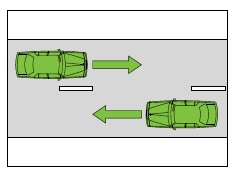Broken white dividing lines
If you are on a road with a broken white line down the middle, you must:
- stay to the left of the lines
- drive as close to the left side of the road as you can.
You can:
- cross these lines to enter or leave the road
- overtake or do a U-turn if it is safe, the road ahead is clear, and you follow all other road rules.

Single continuous dividing lines
If you are on a road with a single continuous line down the middle, you must:
- stay to the left of the lines
- drive as close to the left side of the road as you can.
You can cross these lines to enter or leave the road, or to overtake a bicycle rider when there is a clear view ahead and it is safe to do so. If it’s not safe you need to wait until you find a suitable place to pass
You can't:
- overtake (except a bicycle rider as described above), or do a U-turn
- park opposite the dividing line unless there is at least three metres between your vehicle and the line or there is a sign saying that parking is allowed.

Double continuous dividing lines
If you are on a road with 2 continuous lines (double lines) down the middle, you must:
- stay to the left of the lines at all times
- drive as close to the left side of the road as you can.
You are not allowed to cross over these lines for any reason, unless you have to avoid an obstruction* or to overtake a bicycle rider when there is a clear view ahead and it is safe to do so. If it’s not safe you need to wait until you find a suitable place to pass.
You can't overtake (except a bicycle rider as described above), turn, or enter or leave the road across double lines.
Continuous double dividing lines that are wider apart may look different, but the road rule remains the same.
* the definition of an obstruction includes a traffic hazard, but does not include a vehicle only because the vehicle is stopped in traffic or is travelling more slowly than other vehicles.
A broken line to the left of a continuous line
If you are on a road with a broken white to the left of a continuous line, you must:
- stay to the left of the lines
- drive as close to the left side of the road as you can.
You can:
- cross these lines to enter or leave the road
- overtake or do a U-turn if it is safe, the road ahead is clear, and you follow all other road rules.
A broken line to the left of a continuous line that is wider apart may look different, but the road rule remains the same.

A broken line to the right of a continuous line
If you are on a road with a broken line to the right of a continuous line, you must:
- stay to the left of the lines
- drive as close to the left side of the road as you can.
You can cross these lines to enter or leave the road or to overtake a bicycle rider when there is a clear view ahead and it is safe to do so. If it’s not safe you need to wait until you find a suitable place to pass.
You can't:
- overtake (except a bicycle rider as described above), or do a U-turn
- park opposite the dividing line unless there is at least three metres between your vehicle and the dividing line or there is a parking sign saying that parking is allowed.
A broken line to the right of a continuous line that is wider apart may look different, but the road rule remains the same.

Wider gap between dividing lines
Remember, for dividing lines with a wider gap the road rules remain the same.

For more information see Wide Centreline Road Rules [PDF 1.21 Mb]